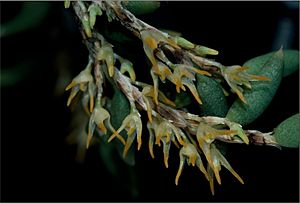Tangled rope orchid facts for kids
Quick facts for kids Tangled rope orchid |
|
|---|---|
 |
|
| Bulbophyllum gadgarrense on Mt Haig, Cape York | |
| Scientific classification | |
| Genus: |
Bulbophyllum
|
| Species: |
gadgarrense
|
| Synonyms | |
|
|
Bulbophyllum gadgarrense, also called the tangled rope orchid, is a special kind of plant that grows on other plants. It is a type of orchid. This orchid has small, hidden bulbs and dark green leaves. Its tiny white flowers often have orange or yellow tips. You can find it growing on rainforest trees in tropical North Queensland, Australia.
What Does It Look Like?
The tangled rope orchid is a plant without a woody stem. It has long, tangled stems that branch out and hang down. These stems can be about 100–200 mm (4–8 in) long. The stems have purplish-brown leaf-like parts called bracts. These bracts hide the orchid's small, rounded storage parts called pseudobulbs. The pseudobulbs are only about 4–6 mm (0.16–0.24 in) long.
Each pseudobulb has one thick, dark green leaf. The leaves are about 15–30 mm (0.6–1 in) long and have a narrow groove. They also have a short stalk.
The Flowers
A single flower grows on a very thin stem. Each flower is small, about 5–6 mm (0.20–0.24 in) long. The flowers are mostly whitish. They often have bright orange or yellow tips.
The flower parts include fleshy sepals, which are about 5–6 mm (0.20–0.24 in) long. The petals are smaller, about 2 mm (0.08 in) long. The special lip of the flower, called the labellum, is tiny and fleshy.
This orchid usually blooms between July and September.
How It Got Its Name
The tangled rope orchid was first officially described in 1949. A scientist named Herman Rupp gave it its scientific name, Bulbophyllum gadgarrense. He wrote about it in a scientific paper.
The plant was found near a place called Gadgarra in the Atherton Tableland. The second part of its name, gadgarrense, refers to this location. It tells us where the first plant of this type was found.
Where It Lives
The tangled rope orchid grows on rainforest trees. It likes parts of the trees that are covered in moss. It also needs good air movement around it.
You can find this orchid in Queensland, Australia. It grows in an area between the Big Tableland and the Tully River.

